Experimental Study on Shear Characteristics of Structural Plane with Different Fluctuation Characteristics
Abstract
:1. Introduction
2. Experimental Design and Preparation
2.1. Preparation of Test Samples
2.2. Testing Equipment and Methods
3. Test Results and Analysis
3.1. Effect of Normal Stress under Different Undulating Angles
3.2. Effect of Shear Rate under Different Undulating Angles
3.3. Failure Analysis of Structural Plane
4. Conclusions
- (1)
- The shear stress–displacement curve of the non-flat structural plane had obvious peak characteristics. The first shear stress peak was caused by the mechanical bite force between the undulating angles, and the second shear stress peak was mainly determined by the friction force between the structural planes.
- (2)
- For a structural plane with the same undulating angle, the shear strength increased approximately linearly with the increase in normal stress. The increment speed was approximately 0.82, while the shear strength w negatively correlated with the shear rate, and which with a high undulating angle, was greatly affected by the shear rate (the shear stress decreased by 2.31 MPa at a 40° angle).
- (3)
- As the normal stress and the shear rate were fixed, the shear strength corresponding to the structural surface gradually increased with the increase in the undulating angle, and the maximum increment was 5.04 MPa at 4 MPa normal stress and a 0.6 mm/min shear rate.
- (4)
- With an increase in the undulating angle, the mechanical bite force of the structural plane increased, and its shear failure became more obvious. The shear wear particles further increased the friction force between the structural planes, thereby increasing the shear strength.
- (5)
- When the undulating angle was 40°, the shear point was closer to the tooth valley position, while the normal stress was higher (6 and 8 MPa), and the shear process was increasingly sufficient as the shear rate became lower (0.6 mm/min). These conditions made the friction features of the shear surface more visible and the corresponding shear strength also increased.
Author Contributions
Funding
Data Availability Statement
Conflicts of Interest
References
- Shaunik, D.; Singh, M. Strength behaviour of a model rock intersected by non-persistent joint. J. Rock Mech. Geotech. Eng. 2019, 11, 1243–1255. [Google Scholar] [CrossRef]
- Fan, Q.; Feng, X.; Weng, W.; Fan, Y.; Jiang, Q. Unloading performances and stabilizing practices for columnar jointed basalt: A case study of Baihetan hydropower station. J. Rock Mech. Geotech. Eng. 2017, 9, 1041–1053. [Google Scholar] [CrossRef]
- Wang, D.; Li, X.; Li, G.; Mao, T.; Zheng, B. The Characterization of Shale Differences Based on Petrophysical Properties and Pore Structure: A Case Study of the Longmaxi Formation in Northern Guizhou Province and the Yanchang Formation in the Ordos Basin. Appl. Sci. 2022, 12, 5303. [Google Scholar] [CrossRef]
- Wan, J.; Peng, T.; Shen, R.; Jurado, M.J. Numerical model and program development of TWH salt cavern construction for UGS. J. Pet. Sci. Eng. 2019, 179, 930–940. [Google Scholar] [CrossRef] [Green Version]
- Wan, J.; Peng, T.; Yuan, G.; Ban, F.; Jurado, M.J.; Xia, Y. Influence of tubing/oil-blanket lifting on construction and geometries of two-well-horizontal salt caverns. Tunn. Undergr. Space Technol. 2021, 108, 103688. [Google Scholar] [CrossRef]
- Yang, C.; Jing, W.; Daemen, J.J.; Zhang, G.; Du, C. Analysis of major risks associated with hydrocarbon storage caverns in bedded salt rock. Reliab. Eng. Syst. Saf. 2013, 113, 94–111. [Google Scholar] [CrossRef]
- Guo, Y.; Deng, P.; Yang, C.; Chang, X.; Wang, L.; Zhou, J. Experimental Investigation on Hydraulic Fracture Propagation of Carbonate Rocks under Different Fracturing Fluids. Energies 2018, 11, 3502. [Google Scholar] [CrossRef] [Green Version]
- Xu, M.; Li, X.; Liu, T.; Luo, Y.; Huang, J.; Wang, G.; Wang, Y.; Gao, W. A study on hollow effect and safety design of deep crossing caverns under blasting vibration. Tunn. Undergr. Space Technol. 2021, 111, 103866. [Google Scholar] [CrossRef]
- Barton, N. Review of a new shear-strength criterion for rock joints. Eng. Geol. 1973, 7, 287–332. [Google Scholar] [CrossRef]
- Meng, F.; Zhou, H.; Wang, Z.; Zhang, L.; Kong, L.; Li, S.; Zhang, C. Experimental study on the prediction of rockburst hazards induced by dynamic structural plane shearing in deeply buried hard rock tunnels. Int. J. Rock Mech. Min. Sci. 2016, 86, 210–223. [Google Scholar] [CrossRef]
- Fang, J.; Kong, G.; Yang, Q. Group Performance of Energy Piles under Cyclic and Variable Thermal Loading. J. Geotech. Geoenvironmental Eng. 2022, 148, 04022060. [Google Scholar] [CrossRef]
- Li, J.; Wan, J.; Liu, H.; Jurado, M.J.; He, Y.; Yuan, G.; Xia, Y. Stability Analysis of a Typical Salt Cavern Gas Storage in the Jintan Area of China. Energies 2022, 15, 4167. [Google Scholar] [CrossRef]
- Caleb, W.; Jan, T. Formation and maintenance of shear zones. Geology 2006, 34, 105–108. [Google Scholar]
- Belem, T.; Souley, M.; Homand, F. Modeling surface roughness degradation of rock joint wall during monotonic and cyclic shearing. Acta Geotech. 2007, 2, 227–248. [Google Scholar] [CrossRef]
- Pirzada, M.A.; Bahaaddini, M.; Moradian, O.; Roshan, H. Evolution of contact area and aperture during the shearing process of natural rock fractures. Eng. Geol. 2021, 291, 106236. [Google Scholar] [CrossRef]
- Li, J.; Wan, J.; Wang, T.; Yuan, G.; Jurado, M.J.; He, Q. Leakage simulation and acoustic characteristics based on acoustic logging by ultrasonic detection. Adv. Geo-Energy Res. 2022, 6, 181–191. [Google Scholar] [CrossRef]
- Zhao, Z.; Wang, W.; Wang, L.; Dai, C. Compression–shear strength criterion of coal–rock combination model considering interface effect. Tunn. Undergr. Space Technol. 2015, 47, 193–199. [Google Scholar] [CrossRef]
- Deng, D. Limit equilibrium analysis on the stability of rock wedges with linear and nonlinear strength criteria. Int. J. Rock Mech. Min. Sci. 2021, 148, 104967. [Google Scholar] [CrossRef]
- He, Z.; Zhu, Z.; Ni, X.; Li, Z. Shear creep tests and creep constitutive model of marble with structural plane. Eur. J. Environ. Civ. Eng. 2019, 23, 1275–1293. [Google Scholar] [CrossRef]
- Xiao, W.; Dui, G.; Chen, T.; Ren, Q. A study of constitutive model coupling dilatancy and degradation for jointed rock. Chin. J. Rock Mech. Eng. 2009, 28, 2535–2543. [Google Scholar]
- Tang, Z.; Xia, C.; Xiao, S. Constitutive model for joint shear stress-displacement and analysis of dilation. Chin. J. Rock Mech. Eng. 2011, 30, 917–925. [Google Scholar]
- Tan, X.; Ren, Y.; Li, T.; Zhou, S.; Zhang, J.; Zhou, S. In-situ direct shear test and numerical simulation of slate structural planes with thick muddy interlayer along bedding slope. Int. J. Rock Mech. Min. Sci. 2021, 143, 104791. [Google Scholar] [CrossRef]
- Naji, A.; Rehman, H.; Emad, M.; Yoo, H. Impact of shear zone on rockburst in the deep neelum-jehlum hydropower tunnel: A numerical modeling approach. Energies 2018, 11, 1935. [Google Scholar] [CrossRef]
- Badika, M.; EI Merabi, B.; Capdevielle, S.; Dufour, F.; Saletti, D.; Briffaut, M. Influence of Concrete–Rock Bonds and Roughness on the Shear Behavior of Concrete–Rock Interfaces under Low Normal Loading, Experimental and Numerical Analysis. Appl. Sci. 2022, 12, 5643. [Google Scholar] [CrossRef]
- Zhang, Y.; Wang, D.; Tang, H.; Li, C.; Yi, X. Study of shear strength characteristics of heterogeneous discontinuities using PFC2D simulation. Rock Soil Mech. 2016, 37, 1031–1041. [Google Scholar]
- Liu, X.; Xu, B.; Huang, J.; Lin, G.; Zhou, X.; Wang, J.; Xiong, F. Macro-meso shear mechanical behaviors of coalescent rock joints with different morphologies. Chin. J. Geotech. Eng. 2021, 43, 406–415. [Google Scholar]
- Ghazvinian, A.; Sarfarazi, V.; Schubert, W.; Blumel, M. A study of the failure mechanism of planar non-persistent open joints using PFC2D. Rock Mech. Rock Eng. 2012, 45, 677–693. [Google Scholar] [CrossRef]
- Sarfarazi, V.; Ghazvinian, A.; Schubert, W.; Blumel, M.; Nejati, H.R. Numerical simulation of the process of fracture of echelon rock joints. Rock Mech. Rock Eng. 2014, 47, 1355–1371. [Google Scholar] [CrossRef]
- Huang, M.; Du, S.; Luo, Z.; Ni, X. Study of shear strength characteristics of simulation rock structural planes based on multi-size direct shear tests. Rock Soil Mech. 2013, 34, 3180–3186. [Google Scholar]
- Dong, S.; Feng, W.; Yin, Y.; Hu, R.; Dai, H.; Zhang, G. Calculating the permanent displacement of a rock slope based on the shear characteristics of a structural plane under cyclic loading. Rock Mech. Rock Eng. 2022, 53, 4583–4598. [Google Scholar] [CrossRef]
- Seidel, J.; Haberfield, C. The application of energy principles to the determination of the sliding resistance of rock joints. Rock Mech. Rock Eng. 1995, 28, 211–226. [Google Scholar] [CrossRef]
- Kwon, T.; Hong, E.; Cho, G. Shear behavior of rectangular-shaped asperities in rock joints. KSCE J. Civ. Eng. 2010, 14, 323–332. [Google Scholar] [CrossRef]
- Lu, H.; Zhu, C.; Liu, Q. Study on shear mechanical properties of structural planes grouted with different materials. J. Rock Mech. Eng. 2021, 40, 1803–1811. [Google Scholar]
- Xu, J.; Lei, J.; Liu, Y. Experimental study on shear behavior of joints filled with different materials. Rock Soil Mech. 2019, 40, 4129–4137. [Google Scholar]
- Gu, D.; Liu, H.; Gao, X.; Huang, D.; Zhang, W. Influence of cyclic wetting–drying on the shear strength of limestone with a soft interlayer. Rock Mech. Rock Eng. 2021, 54, 4369–4378. [Google Scholar] [CrossRef]
- Wu, M.; Wang, W.; Shi, D.; Song, Z.; Li, M.; Luo, Y. Improved box-counting methods to directly estimate the fractal dimension of a rough surface. Measurement 2021, 177, 109303. [Google Scholar] [CrossRef]
- Han, L.; Wang, L.; Zhang, W.; Geng, B.; Li, S. Rockhead profile simulation using an improved generation method of conditional random field. J. Rock Mech. Geotech. Eng. 2022, 14, 896–908. [Google Scholar] [CrossRef]

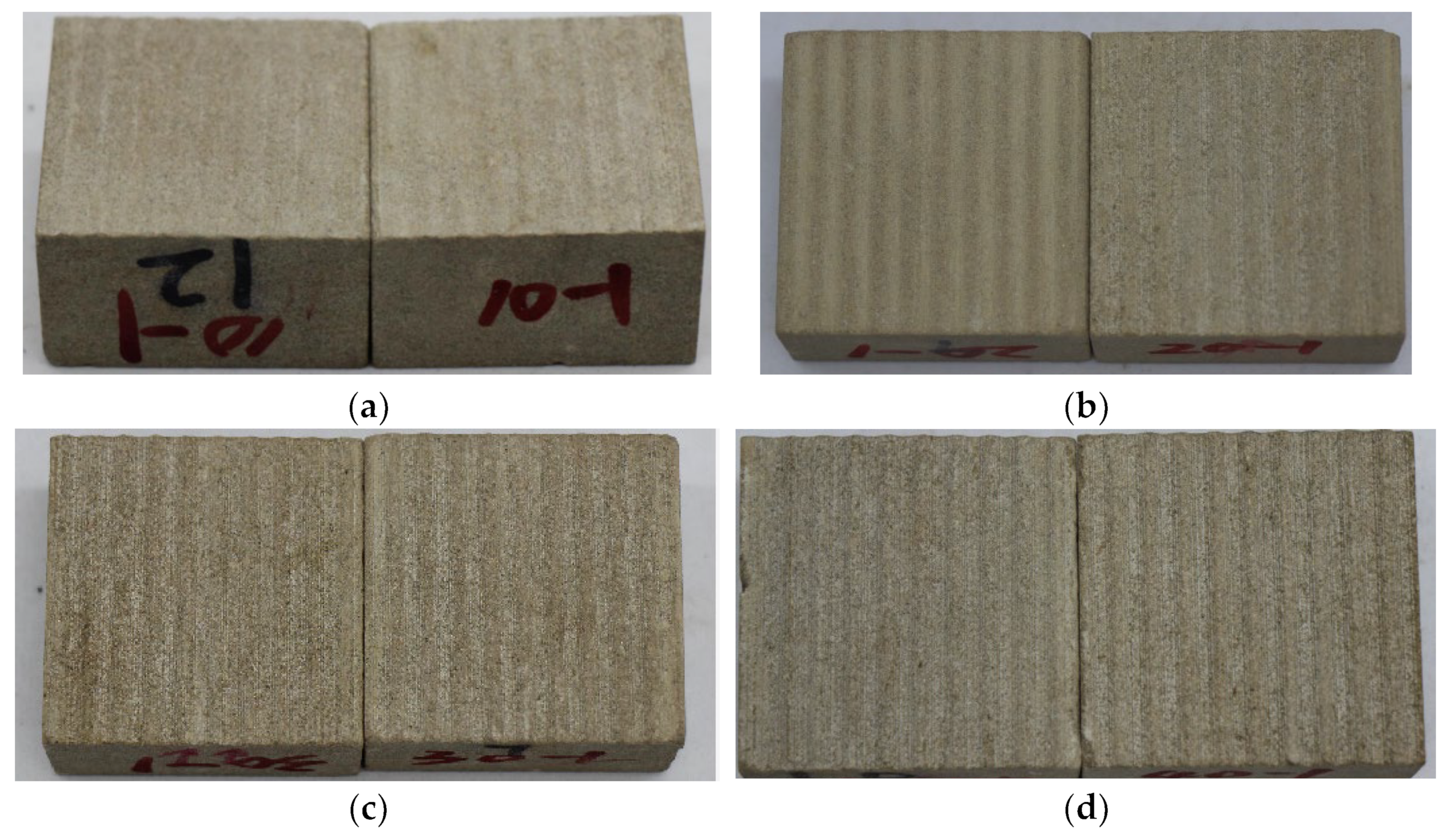






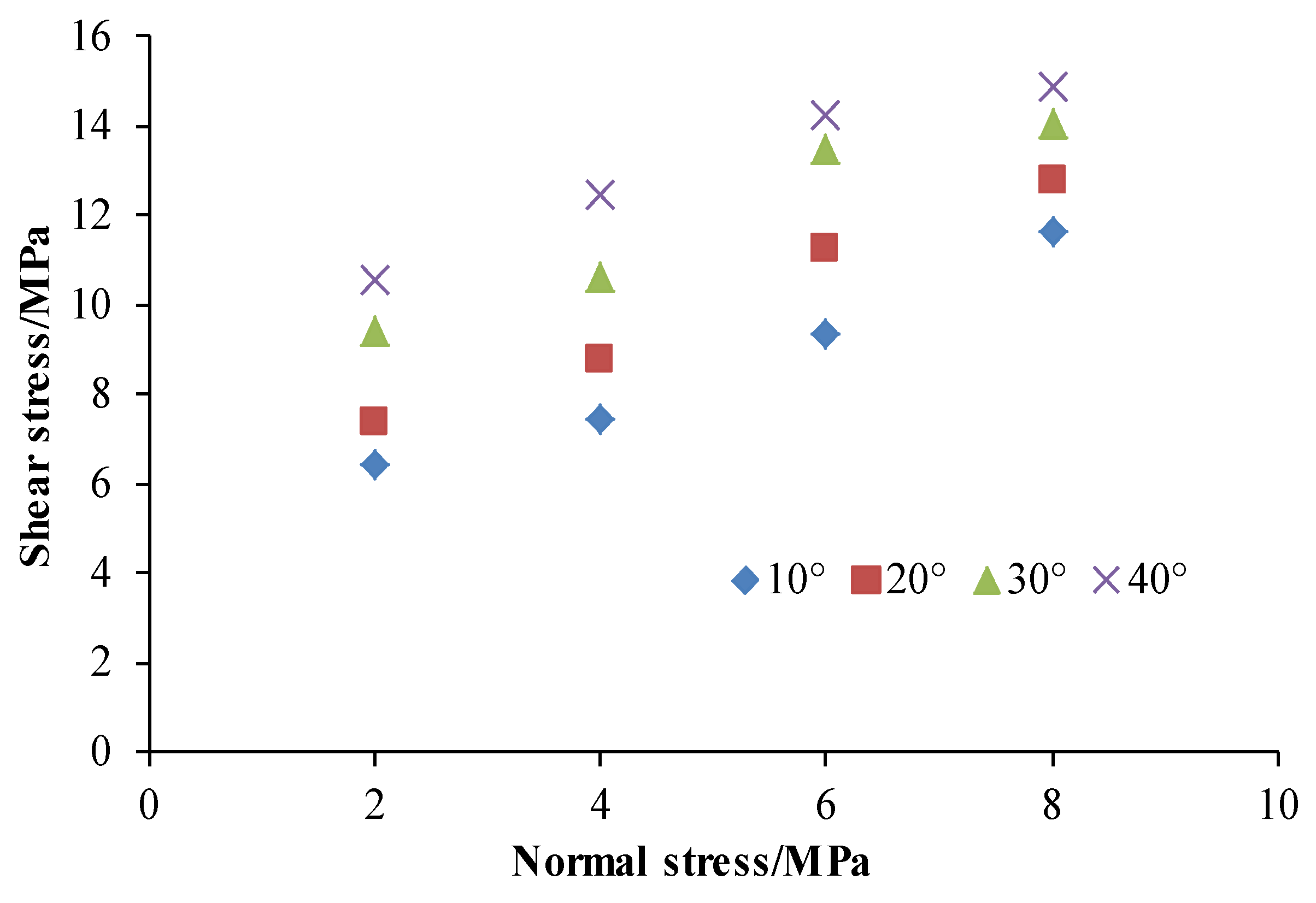
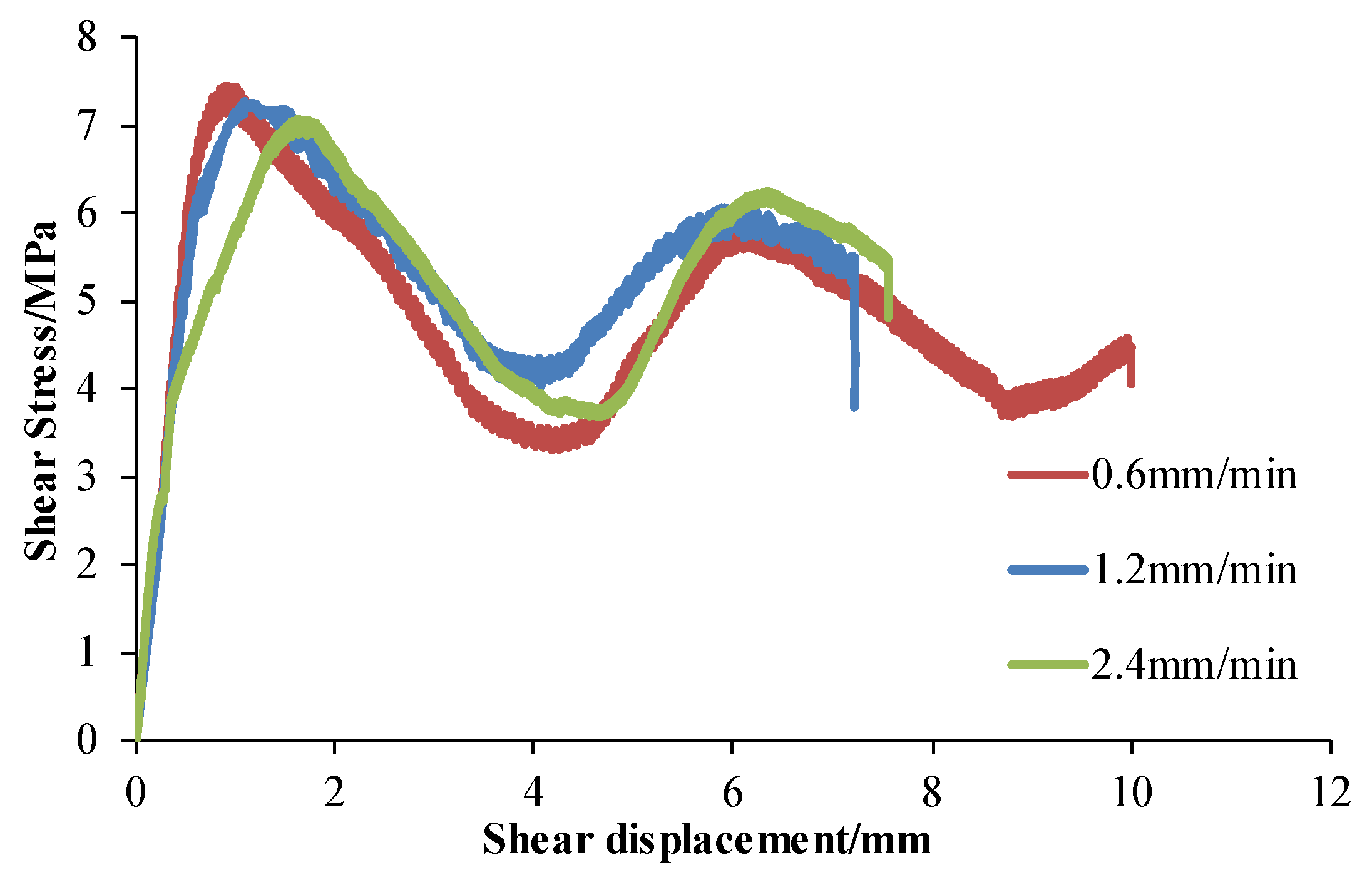
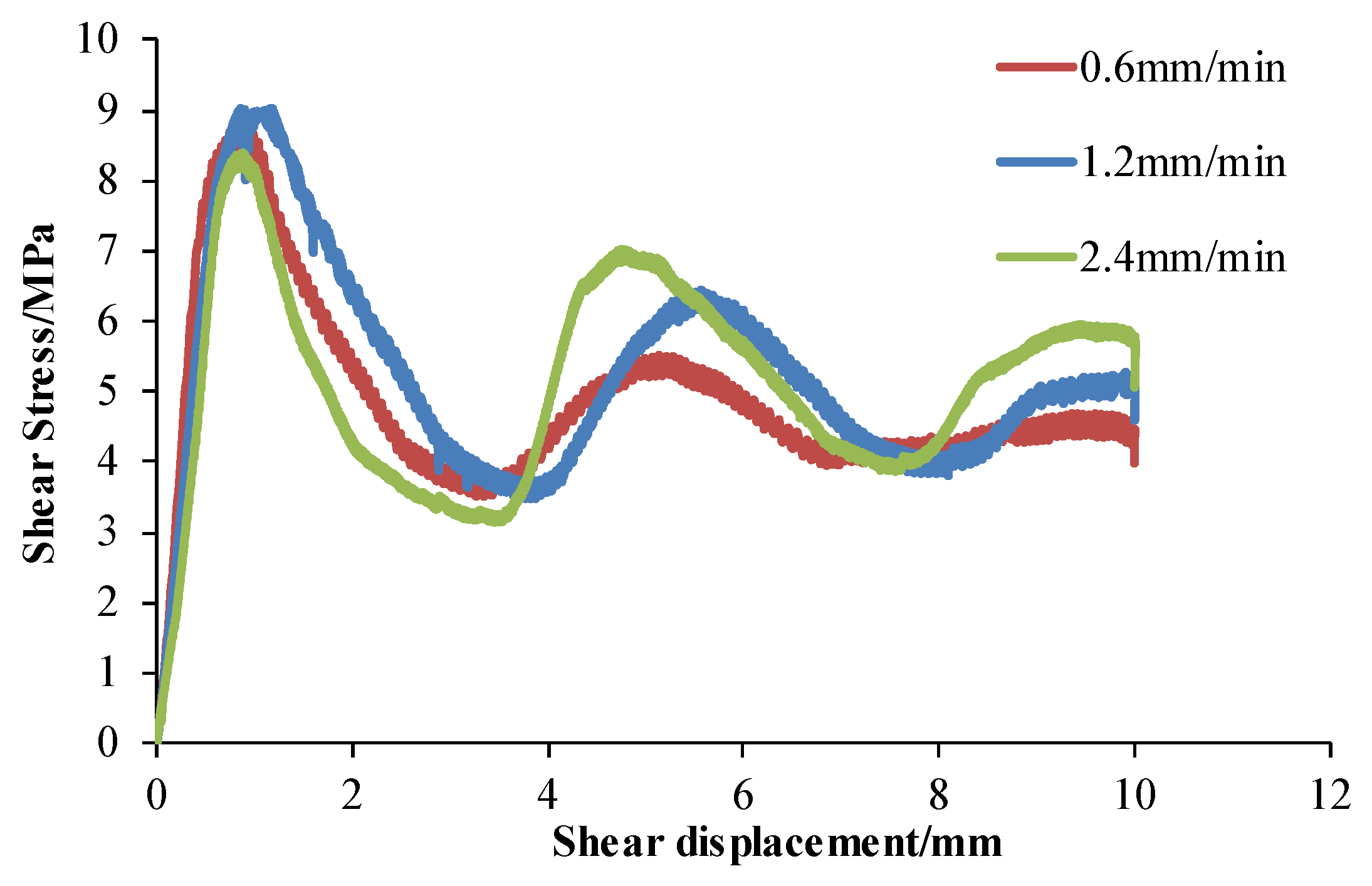

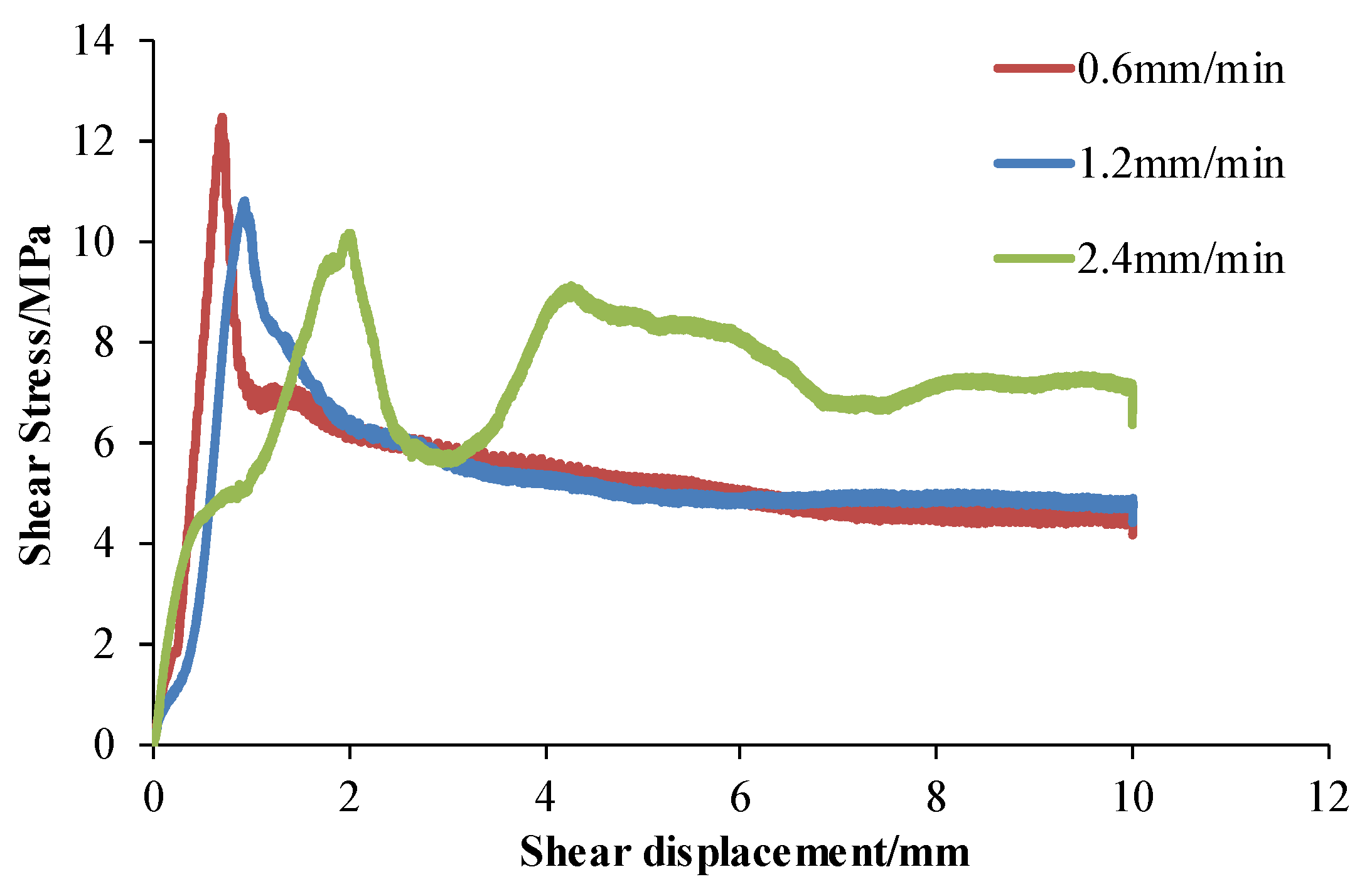



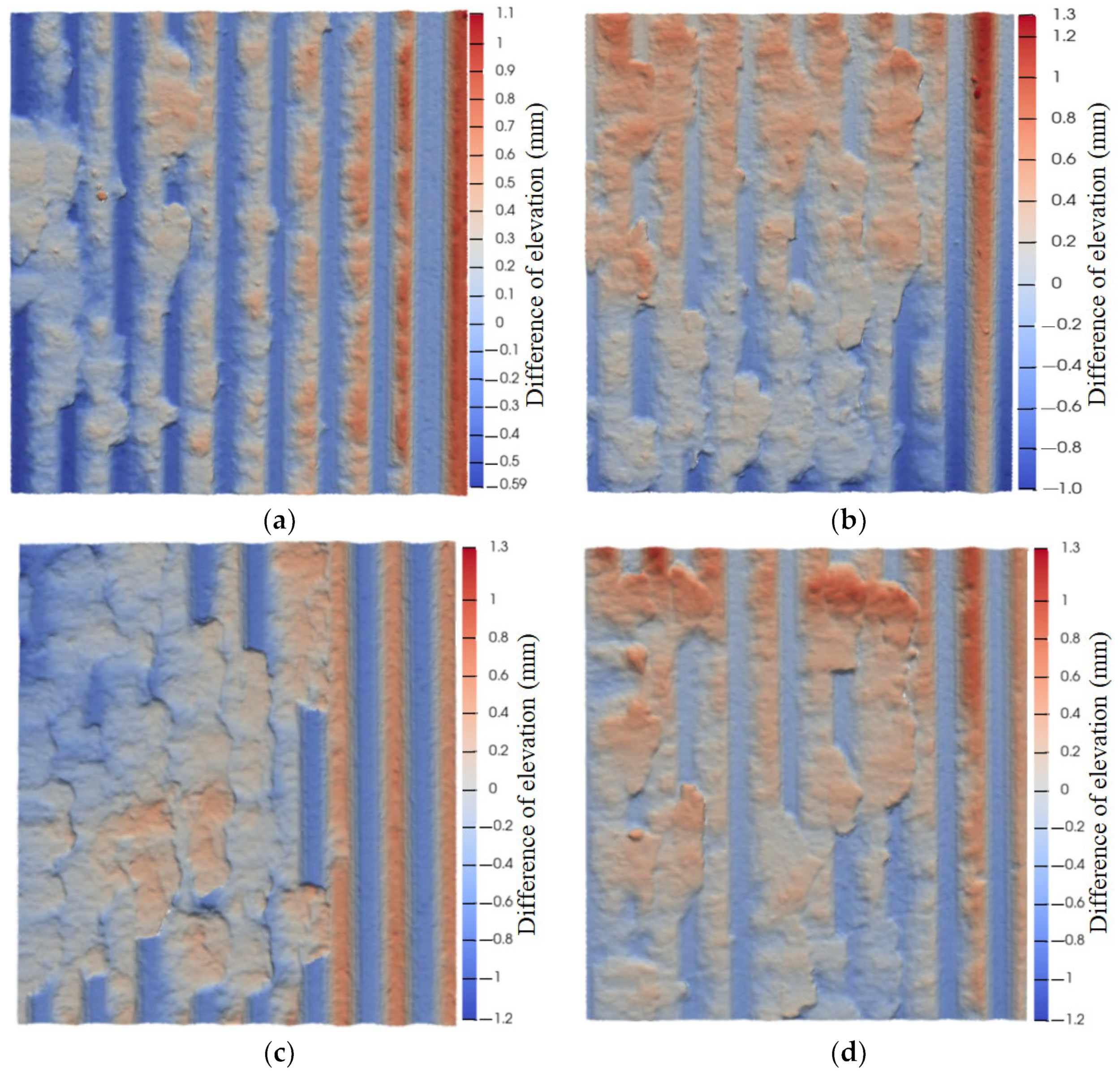

| Sample Number | Undulating Angle (°) | Normal Load (kN) | Normal Stress (MPa) | Shear Rate (mm/min) |
|---|---|---|---|---|
| 10-1 | 10 | 5 | 2 | 0.6 |
| 10-2 | 10 | 10 | 4 | 0.6 |
| 10-3 | 10 | 15 | 6 | 0.6 |
| 10-4 | 10 | 20 | 8 | 0.6 |
| 10-5 | 10 | 10 | 4 | 1.2 |
| 10-6 | 10 | 10 | 4 | 2.4 |
| 20-1 | 20 | 5 | 2 | 0.6 |
| 20-2 | 20 | 10 | 4 | 0.6 |
| 20-3 | 20 | 15 | 6 | 0.6 |
| 20-4 | 20 | 20 | 8 | 0.6 |
| 20-5 | 20 | 10 | 4 | 1.2 |
| 20-6 | 20 | 10 | 4 | 2.4 |
| 30-1 | 30 | 5 | 2 | 0.6 |
| 30-2 | 30 | 10 | 4 | 0.6 |
| 30-3 | 30 | 15 | 6 | 0.6 |
| 30-4 | 30 | 20 | 8 | 0.6 |
| 30-5 | 30 | 10 | 4 | 1.2 |
| 30-6 | 30 | 10 | 4 | 2.4 |
| 40-1 | 40 | 5 | 2 | 0.6 |
| 40-2 | 40 | 10 | 4 | 0.6 |
| 40-3 | 40 | 15 | 6 | 0.6 |
| 40-4 | 40 | 20 | 8 | 0.6 |
| 40-5 | 40 | 10 | 4 | 1.2 |
| 40-6 | 40 | 10 | 4 | 2.4 |
| Undulating Angle (°) | Normal Stress (MPa) | Shear Rate (mm/min) | |||
|---|---|---|---|---|---|
| 2 | 4 | 6 | 8 | ||
| 10 | 6.42 | 7.45 | 9.34 | 11.67 | 0.6 |
| 20 | 7.36 | 8.76 | 11.24 | 12.77 | |
| 30 | 9.44 | 10.63 | 13.51 | 14.07 | |
| 40 | 10.54 | 12.49 | 14.22 | 14.9 | |
| Undulating Angle (°) | Shear Rate (mm/min) | Normal Stress (MPa) | ||
|---|---|---|---|---|
| 0.6 | 1.2 | 2.4 | ||
| 10 | 7.45 | 7.28 | 7.08 | 4 |
| 20 | 8.76 | 9.03 | 8.39 | |
| 30 | 10.63 | 10.01 | 9.49 | |
| 40 | 12.49 | 10.83 | 10.18 | |
Publisher’s Note: MDPI stays neutral with regard to jurisdictional claims in published maps and institutional affiliations. |
© 2022 by the authors. Licensee MDPI, Basel, Switzerland. This article is an open access article distributed under the terms and conditions of the Creative Commons Attribution (CC BY) license (https://creativecommons.org/licenses/by/4.0/).
Share and Cite
Guo, Y.; Ying, Q.; Wang, D.; Zhang, H.; Huang, F.; Guo, H.; Hou, L.; Xu, M.; Liu, H.; Xia, D. Experimental Study on Shear Characteristics of Structural Plane with Different Fluctuation Characteristics. Energies 2022, 15, 7563. https://doi.org/10.3390/en15207563
Guo Y, Ying Q, Wang D, Zhang H, Huang F, Guo H, Hou L, Xu M, Liu H, Xia D. Experimental Study on Shear Characteristics of Structural Plane with Different Fluctuation Characteristics. Energies. 2022; 15(20):7563. https://doi.org/10.3390/en15207563
Chicago/Turabian StyleGuo, Yintong, Qiqi Ying, Duocai Wang, Hong Zhang, Famu Huang, Haitao Guo, Lei Hou, Mingnan Xu, Hejuan Liu, and Debin Xia. 2022. "Experimental Study on Shear Characteristics of Structural Plane with Different Fluctuation Characteristics" Energies 15, no. 20: 7563. https://doi.org/10.3390/en15207563






